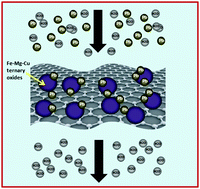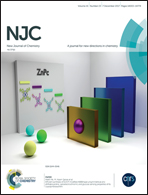Effective removal of Pb(ii) using a graphene@ternary oxides composite as an adsorbent in aqueous media†
Abstract
Lead is a non-biodegradable heavy metal that easily accumulates in the human body, causing anemia, cancer, renal kidney disease, nervous system damage and mental retardation. In this study, a new lead adsorbent of graphene@Fe–Mg–Cu ternary oxide composite was successfully fabricated using a one-spot thermal decomposition approach. The prepared material was fully characterized via scanning electron microscopy (SEM), high-resolution transmission electron microscopy (HRTEM), electron dispersive spectroscopy (EDS), BET surface area and X-ray photoelectron spectroscopy (XPS). The lead adsorption behaviour of the prepared graphene@Fe–Mg–Cu ternary oxides was studied by batch and column experiments. The adsorption isotherm was described by both the Langmuir and Freundlich models and the sorption kinetics of lead adsorption by the composite was found to be pseudo-second order. The graphene@Fe–Mg–Cu ternary oxides exhibited exceptional and fast adsorption of lead over a wide range of solution pHs with remarkable durability, selectivity, and recyclability, which could make this composite a very promising candidate for effective removal of lead from aqueous solutions.



 Please wait while we load your content...
Please wait while we load your content...